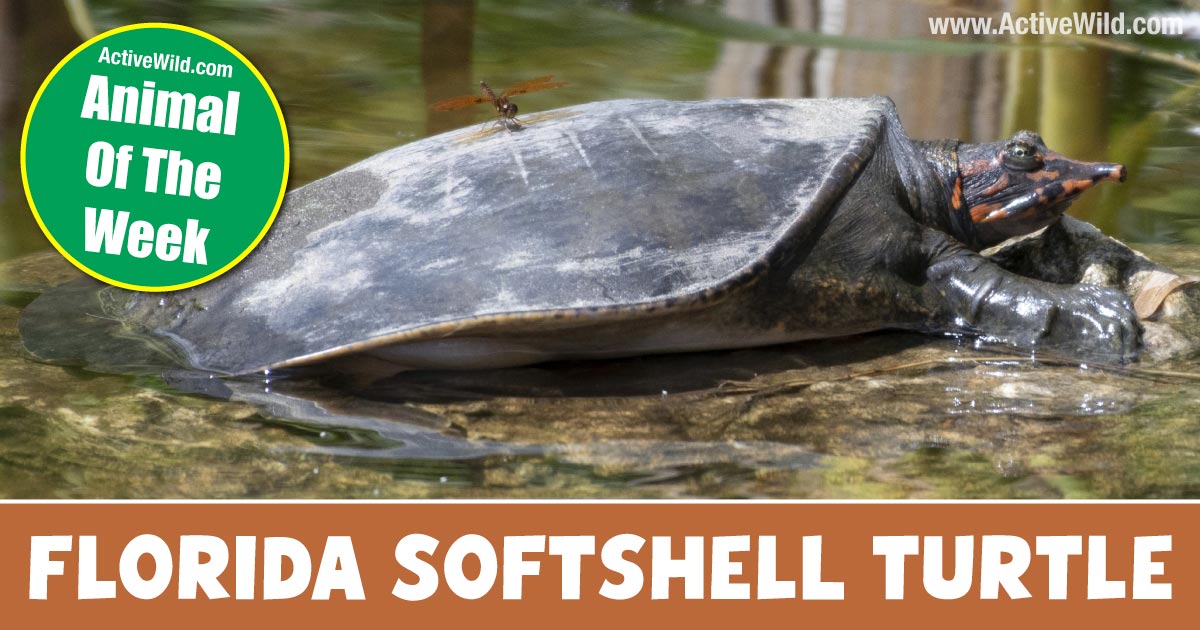The Florida softshell turtle, Apalone ferox, is a distinctive turtle found in Florida and neighboring states. Like other members of the softshell turtle family, Trionychidae, the Florida softshell turtle has a leathery shell, rather than the hard shell found on most other turtle species.
On this page, you’ll find Florida softshell facts and pictures to help you identify and understand the life of this fascinating North American reptile.
Have you seen this or any other turtle species in the wild? Report your sighting in the comments section at the bottom of the page!
Related Pages
- Visit our main animals page for links to animal information and a complete guide to the animal kingdom: Animals
- Discover different types of turtles on this page: Types of Turtles
Florida Softshell Turtle

- Scientific Name: Apalone ferox
- Order: Testudines
- Family: Trionychidae (softshell turtles)
- Length: 0.3 to 0.76 meters (1 to 2.5 feet) for females, males are significantly smaller
- Weight: Up to 20 kg (44 lb.) for large females, males are much lighter
- Where found: Southeastern United States, predominantly in Florida
- IUCN conservation status: Least Concern
Introduction: What is a Florida Softshell Turtle?
The Florida softshell turtle, Apalone ferox, is a distinctive species of freshwater turtle native to the southeastern United States, predominantly found in Florida.
One of the most distinguishing features of this species is its leathery, rather than hard, shell, from which its common name is derived. The turtle has a long, tubular nose, webbed feet, and a generally pancake-like body shape, setting it apart from more conventional turtle species.
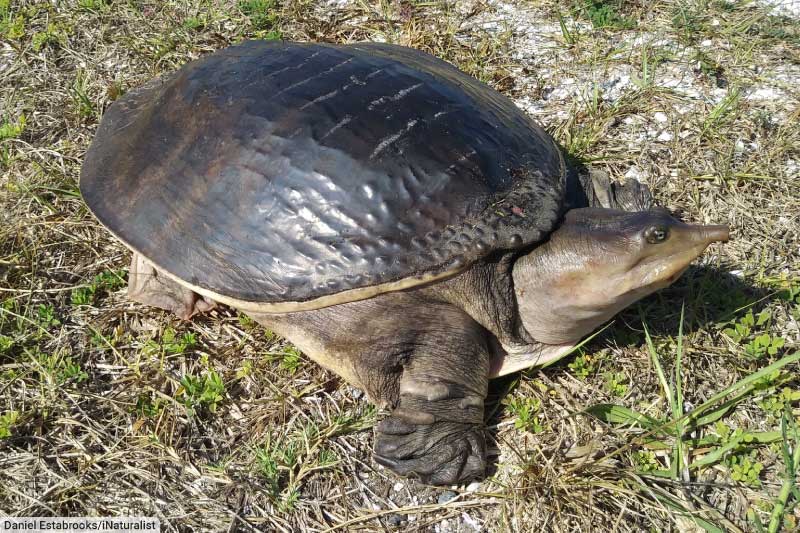
In terms of size, the Florida softshell can become quite large, with females, which are noticeably bigger than males, reaching shell lengths of up to two feet or more. The species is predominantly aquatic, favoring slow-moving or still bodies of water, such as ponds, marshes, and lakes.
Though they might appear docile, Florida softshell turtles can be aggressive when threatened, using their powerful jaws to defend themselves. Their primary diet consists of fish, snails, crustaceans, insects, and even some aquatic plants.
Compared to hard shelled turtles, softshell turtles are fast-moving, both on land and in the water.
What Does A Florida Softshell Turtle Look Like?
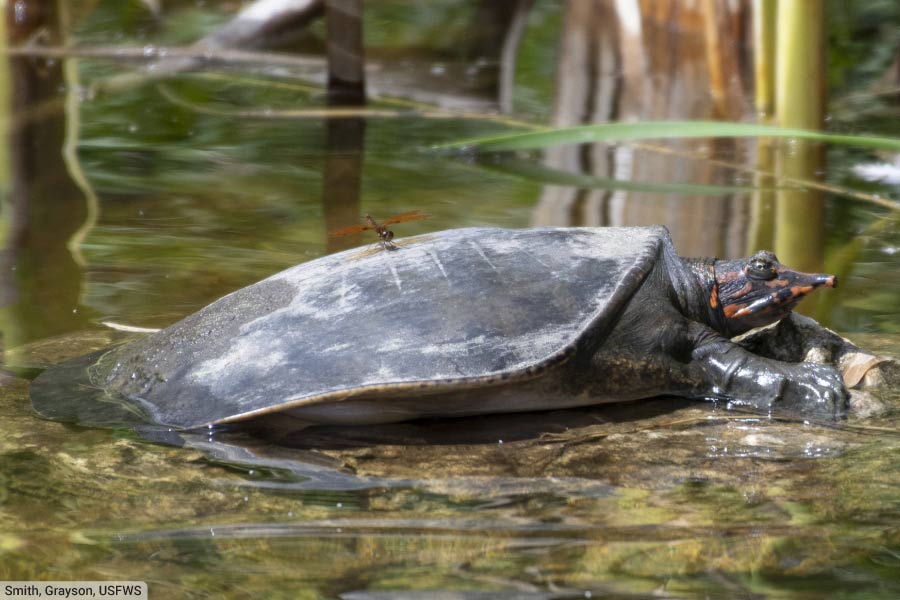
The Florida softshell turtle has several distinctive characteristics that make it relatively easy to identify when compared to other freshwater turtles. Here are key features to help you identify a Florida softshell turtle:
- Soft, Leathery Shell: Unlike most turtles, which have hard, bony shells, the Florida softshell turtle has a cartilaginous shell that is smooth and leathery to the touch. The shell, or carapace, is somewhat flat and lacks the scutes (scales) that most other turtles have.
- Long, Tubular Snout: One of the most distinguishing features of this turtle is its long and tubular nose. It serves as a snorkel when the turtle is submerged, allowing it to breathe without fully surfacing.
- Large Webbed Feet: Its feet are broad and webbed, adapted for its predominantly aquatic lifestyle. Each foot has three claws (the family name Trionychidae means “three-clawed”.)
- Body Color: The turtle’s body color is generally a dark brown to olive green, sometimes even close to black. Juveniles may have bright orange or yellowish markings, but these tend to fade as the turtle matures.
- Size: Females are notably larger than males. A full-grown female can reach lengths of 2.5 feet, while males are much smaller.
- Pancake-like Shape: The Florida softshell has a flattened body shape, resembling a pancake.
- Behavior: They are predominantly aquatic, spending most of their lives in the water. They can often be seen basking on the edges of water bodies. However, when approached or threatened, they can move surprisingly fast and may display an aggressive behavior, hissing and attempting to bite if they feel cornered.
- Location: the Florida softshell turtle is predominantly found in the southeastern United States, mainly in Florida, but also in southern parts of Alabama, Georgia, and South Carolina.
- Male vs Female: female Florida softshell turtles are commonly twice the size of males. In females, the claws on the hind feet are longer than those on the front feet; in males, the opposite is true. The tail of the male extends well beyond the edge of the carapace; the female’s tail is hidden by the carapace.
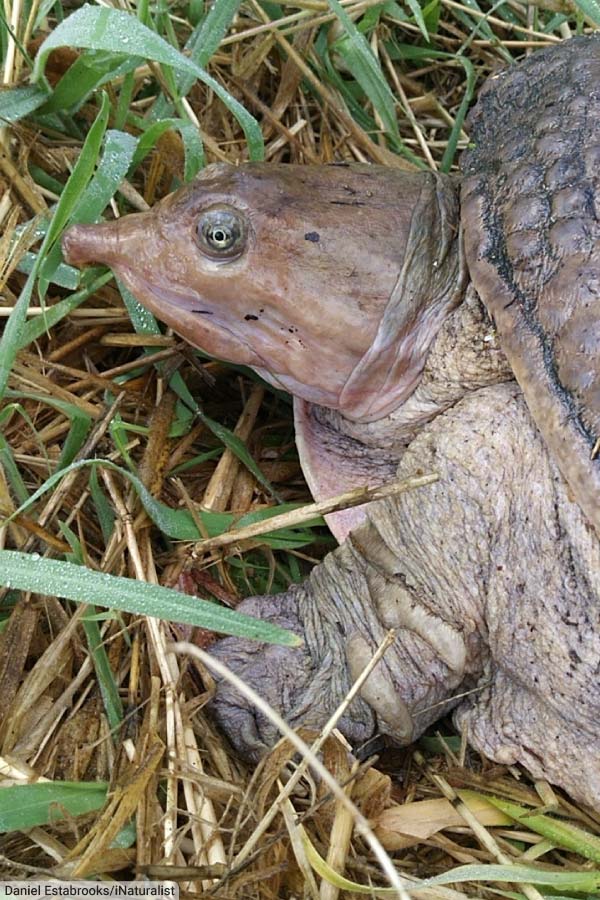
Florida Softshell Turtles Vs Other Softshell Turtles In Florida
Two other species of softshell turtles are found in Florida: the smooth softshell turtle Apalone mutica and the spiny softshell turtle Apalone spinifera, both of which are found only in the Panhandle.
Florida Softshell: Has a dark olive to brown, nearly black, leathery shell. The body tends to be more robust and bulkier. The largest softshell turtle in North America.
Smooth Softshell: As the name implies, this species has a very smooth carapace without the spines or tubercles that other softshells might possess. The shell color can be tan or olive with few markings, although spots and blotches may be present. Pale, unmarked chin and throat.
Spiny Softshell: Notable for the small, spiny projections present on the front edge of its carapace. The overall appearance might be more roughened compared to the smooth softshell. Their carapace can have an array of patterns or spots. Often has pale yellow, black edged stripe running along the sides of the head.
In areas where all three turtles are present, the Florida softshell turtle can be identified by its darker coloration.
Where are Florida Softshell Turtles Found?
The Florida softshell turtle is found in suitable habitats throughout Florida, including both the panhandle and peninsula.
Florida Softshell Turtle Habitat

The Florida softshell turtle inhabits freshwater systems such as lakes, ponds, slow-moving rivers, streams, and marshes. Within these water bodies, the turtle has a preference for soft, muddy bottoms where it can easily dig and conceal itself, with only its eyes and snout exposed. This behavior not only aids the turtle in ambushing prey but also offers protection from predators.
Man-made water bodies, including retention ponds commonly found in urban and suburban areas of Florida, as well as canals, especially those in South Florida, also provide suitable habitats for the Florida softshell turtle, especially when they closely mimic the natural conditions that the turtles prefer.
For reproductive purposes, female Florida softshell turtles come ashore, sometimes traveling considerable distances from their aquatic habitats. They seek out sandy or soft soil to dig a hole and lay their eggs. The chosen habitat should ideally support the turtle’s diet, which consists of small fish, crustaceans, insects, mollusks, and occasionally some aquatic vegetation. Factors like water quality, food availability, suitable nesting sites, and minimal threats from pollution or heavy human disturbance are pivotal for the survival and flourishing of this species in its natural environment.
Florida Softshell Turtle Diet
The Florida softshell turtle is primarily carnivorous, feeding on a range of aquatic animals, with snails and small fish forming the bulk of its diet. The turtle will also eat crustaceans, insects, and amphibians. The turtle has occasionally known to prey on waterfowl.
The turtle’s powerful jaws, sharp beak and speed allow it to pursue and capture its prey. As opportunistic feeders, Florida softshell turtles are known to eat anything that fits into their mouths that meets their dietary preferences.
Florida Softshell Turtle Family And Related Species
The Florida softshell turtle is one of 33 species in the softshell turtle family, Trionychidae. Members of this family are found in North America, Africa and Asia, all being typically large to very large freshwater turtles with a leathery carapace.
Within the family Trionychidae, the Florida softshell turtle belongs to the genus Apalone, which is also home to two other species: the smooth softshell turtle and spiny softshell turtle.
Florida Softshell Turtle Life Cycle

The nesting season of the Florida softshell turtle takes place from late March to July. At intervals during this time, the female will emerge from the water to lay its eggs
Female Florida softshell turtles lay their eggs in nests they dig in sandy or soft soils, usually some distance from the water’s edge. The nests of American alligators are sometimes used by the turtle.
The number of eggs is typically between 10 to 30 eggs per clutch, and females may lay eggs 4 to 6 times each nesting season. A single female may lay over 200 eggs in a single season, and the species has one of the highest egg-laying rates of any reptile. The eggs are spherical and white in color.
After an incubation period that lasts 2 to 3 months, the eggs hatch. Hatchlings are miniature versions of the adults but often have brighter colors. Once they emerge from their nests, the young turtles make their way to a water source.
As juveniles, Florida softshell turtles remain relatively vulnerable to predators due to their smaller size. During this stage, their brighter colors begin to fade to the darker, more muted tones of the adults.
Florida softshell turtles become sexually mature between 5 to 10 years of age. Adults have fewer natural predators, with their primary threats being humans and larger wildlife. They maintain a carnivorous diet, consuming fish, crustaceans, insects, and occasionally some vegetation.
Florida Softshell Turtle Lifespan
The lifespan of the Florida softshell turtle is 20 to 30 years in the wild, though some individuals in captivity have been known to live longer.
Florida Softshell Turtle Predators
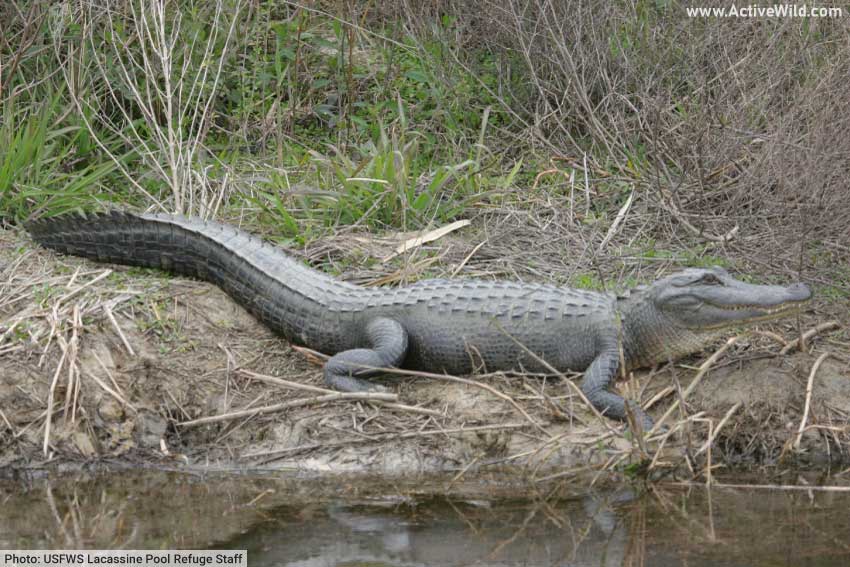
An adult Florida softshell turtle has few predators, due to its size, speed and protective shell. The American alligator is the species’ main predator. As juveniles, the turtles are preyed on by birds of prey, large fish, skunks, armadillos, and even other turtles. The turtle’s eggs are eaten by various species, including birds and raccoons.
Is the Florida Softshell Turtle Endangered?
The Florida softshell turtle is not currently endangered, and the species is rated “Least Concern” by the IUCN. Potential threats to the species include habitat loss and illegal hunting (commercial harvesting and sale of the species is banned in Florida).

